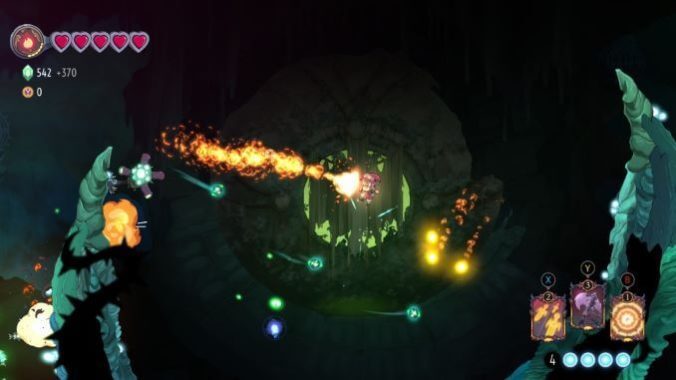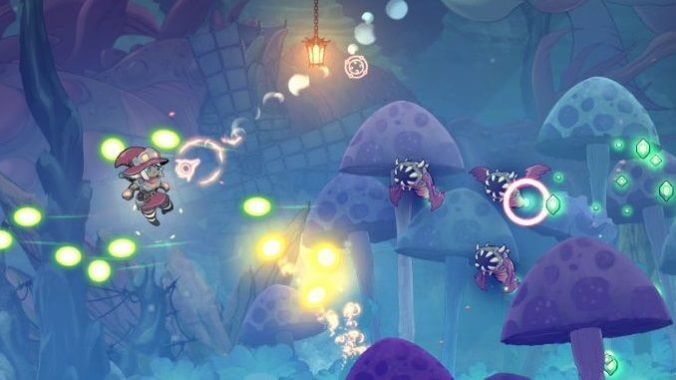The Knight Witch opens on revolutionary violence. A Knight Witch (notably not the titular hero) blasts their way through the last defenses of a crumbling techno-empire. The fractured earth still dies, but there is some hope for a normal life below the surface of the world. Despite the game’s bombastic, girl power premise, it attempts to raise serious political issues. The Knight Witch reaches for the heights of Final Fantasy, where a fantastical narrative earns some socio-political and spiritual heft. It lands closer to the normal malaise of action games, where simple thrills feel like paper over the cracks of an ill-conceived narrative foundation.
Although The Knight Witch’s thrills are predictable, they are competent. The game manages a formula that makes each of its systems both legible and useful. In brief, The Knight Witch is a search action game by way of a twin stick shooter. One stick moves, the other aims. Shoot enemies and dodge their bullets. Face buttons activate spell cards which swap in temporary, but powerful, weapons, unleash special attacks, or bring in creatures to aid you. Using spell cards costs mana, which you can earn back by killing enemies. Even with the light deck building mixed in, most folks who play games regularly should feel at home with The Knight Witch’s basic verbs.
The rest of the game is typical Metroid fare. Explore new areas to gain new abilities to explore new areas. You can also pick up additional card slots, health, and mana by finding items in the interconnected world. The primary twist is in the game’s social angle. The Knight Witches gain their power through “the link,” the belief that other people have in their power and goodness. The more people that you rescue or help, the more power you will gain via level ups.
While The Knight Witch’s world exploration is mostly perfunctory, its combat has some real bite. The simple dance between popping power with spell cards and risking your hide to pick up mana forces the kind of split-second decisions that thrilling action is made from. Boss and enemy design is wily and devious, constantly requiring you to mix up your strategy in fun, and frustrating, ways. Unfortunately, the frustration can overtake the moment-to-moment fun. The Knight Witch is hard, which encourages getting items and level ups. Without fast travel, this means backtracking. While I admire the chutzpah of not granting that simple convenience, The Knight Witch’s world is simply not that compelling to explore. The necessity of upgrades and the rate of new abilities also ensures that you will be revisiting areas often. It gets tiresome, especially on a deadline.
It doesn’t help that the game’s world is a smattering of generic fantasy gestures, influenced more by absentmindedly scrolling through Deviant Art than by any particular artist. In some sense, it’s hard to fault The Knight Witch’s style. It’s slick and shiny, weapons hit with the appropriate punch and sheen. The environments are varied, both musically and in presentation. But frankly, talking about a game’s world in this way is mere gamer nonsense. The Knight Witch’s aural and visual pleasures do not linger, they flicker out. The patterns and textures are flat, basically centered around elements. They are satisfying enough as flashing images, but cannot build to anything more.

Similarly, The Knight Witch’s narrative has ambitions for doing more than merely stringing together encounters, but it approaches its weighty themes with more flatness than grace. To summarize, protagonist Rayne is just a normal woman now, but she used to be a Knight Witch in training. The four other Knight Witches went on to fame and glory, while Rayne settled down and got married. After a time of peace, fragments of the techno-empire return. With the other Knight Witches absent, Rayne must step up as the lone protector of their still fledgling community.
The Knight Witch does get to the point. Almost every detail of the world is immediately plot-relevant and the story is entirely self-contained. As more and more big games chain themselves to webs of external media, it’s refreshing to play some genre fiction that just gets to the point. But when every detail or character is directly related to plot, there is no room for poetry. While the game’s themes reach for sweeping complexity, it does not have the nuance or the space to evoke. It’s as dry as a textbook or a Call of Duty cutscene.
I don’t expect every game, especially one as action-forward as this, to be well written. However, when a game broaches environmental collapse, the ethics of revolutionary violence, the burden placed on public leaders, and the harsh divisions of race and class, it demands serious attention. The Knight Witch states its theses so loudly, and with such false conviction, that it cannot reward that attention.
To be clear, The Knight Witch is not merely didactic, it is confused. The game’s marginalized worker population are demon people called infernals. The robots the techno-empire uses to wage war are called golems, unwittingly tying them to Jewish folklore. I don’t mean to claim that the developers, or their game, are racist or anti-semitic. Rather, I mean to say that they are not giving enough thought to the language they are using. While the infernals are more or less normal humans with horns, and golem is clearly meant to be a flavorful way of saying robot, these names and images mean things in the real world, something The Knight Witch has little interest in pulling from.
This is especially evident in the game’s portrayal of revolutionary leadership. The Knight Witches are at once Bolsheviks and Hobbes’ Leviathan. They gain their power from the people, but also are the only ones responsible for revolutionary action. It’s a fantasy idea, sure, but it results in a lopsided view of community. Only one person really needs to act; everyone else can just sit at home and merely believe. At first, the game seems to make gestures towards the peril of deifying or idealizing leaders. But by game’s end, Rayne fully and justly comes into her power, as every videogame protagonist must.
The developers of The Knight Witch clearly care for nature, but the game they made has no world to preserve or save. It’s populated with cartoon characters that are mostly vague mouthpieces, who are placed in backdrops of fire or water or stone textures. The world only has life when parts of it are dying, when Rayne sets them afire with her spells. The Knight Witch wants you to be invested in its world, in the possibility of its death, in the ability of a community to live freely without exploitation. However, its only poetry is in virtual violence, in the simple thrill of outwitting a computer and watching its shrapnel fade from view.
The Knight Witch was developed by Glitch Factory and published by Ysbryd Games. Our review is based on the PC version. It is also available for PlayStation 5, PlayStation 4, Switch, Xbox Series X|S, and Xbox One.
Grace Benfell is a queer woman, critic, and aspiring fan fiction author. She writes on her blog Grace in the Machine and can be found @grace_machine on Twitter.

